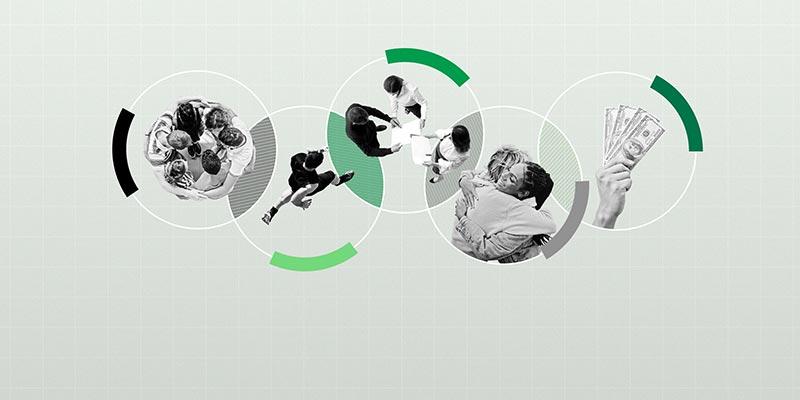Story Highlights
- Working remotely and staying active can happen -- performance depends on it
- Effective remote workers alter their approach to getting work done
- The key to effectively managing employees is individualized coaching
At a time when the spread of COVID-19 makes every cough or sniffle seem like a potential emergency, business leaders are finding themselves revamping their companies into remote work operations.
They'll join the innumerable organizations that already have done so -- 43% of U.S. workers, according to Gallup's State of the American Workplace report, work off-site some or all of the time. And among the many issues that leaders must consider is the physical wellbeing of newly remote workers.
Gallup research shows that the five interconnected elements of wellbeing -- career, social, financial, community and physical -- affect everything from our job performance to our health status. For example, job search intent over the next 12 months among workers who lack high engagement and high wellbeing is 33%. Employee engagement alone lowers this to just 13%, and high wellbeing on top of engagement brings job search intent down to the single digits, to 8%. And when strengths-based development is included, job search intent is cut in half, to just 4%.
But just one in 14 U.S. employees are thriving in all five elements.
Those interconnected elements of wellbeing touch the lives of remote workers just as much as anyone else -- but right now, leaders need to be particularly attuned to remote workers' physical wellbeing. They won't get exercise from climbing office stairs or walking the halls like they used to, and few homes feature a salad bar like company cafeterias do. Meanwhile, gyms are closing all over the country, people may not want to brave crowded stores to buy healthy food, and in-home quarantines may plant people inside for weeks.
But remote workers can still achieve physical wellbeing -- and should, for their sake and your productivity. This is what you should encourage them to do.
- Exercise: Working out at home can offer some advantages such as convenience and privacy. Beginners can start with a routine of core resistance moves, like squats, wall sits, calf raises, planks or crunches. If you can handle more than that, add pushups, lunges or burpees. Set a timer for 10 to 20 minutes, and count the number of reps you accumulate. Do it again the next day, and suddenly you've created a manageable routine with metrics that drive competitive and high-achieving employees. People who are fueled by close interaction might like following a guided workout -- in which case they can download a yoga app or visit a website that offers workouts that are customized and require little or no equipment.
- More than a chore: Daily home upkeep can be a good way to introduce more activity. Turn on some music and groove while you do the dishes, vacuum and sweep with energy, and put some elbow grease into scrubbing. Cleaning with vigor can burn as many calories as some activities in the gym, and it is arguably just as productive. With an eye on the bigger prize of creating an orderly environment, it can be easy to ignore the fact that you're exercising. For bonus points, choose a task that mixes physical activity and a considerable reward, such as decluttering a closet.
- Vitamin D: Open your shades when the sun comes up, or step outside. Bringing sunlight into your home will help balance your circadian rhythm for better sleep and energy management. And stepping outside for even just a quick breath of fresh air will make you feel more alive and less isolated.
- Intervals of work: No one should spend the day in a dark room with a computer, so move around -- write and send emails in your main computer room, take phone calls in the bedroom where it is quiet, and ideate in a room filled with sunshine. Experiment with different surroundings, and be flexible by going back and forth between them throughout the day as you discover where you do your most productive work.
- Social lift: The lack of a commute gives you more time to talk to the people you love -- video chat technology is a great option for those who are far away. And though many are worried about the consequences of a global pandemic or recession, there's plenty of good news to share. So connect with your colleagues and friends by sharing some good news, and ask them to do the same.
- Time for reflection: Being at home for an extended period of time can provide an opportunity for contemplation. Check in on your wellbeing goals, and create new plans for your future. Time for introspection can help sharpen health skills, like mindful eating and self-analysis.
- Grocery delivery: Many supermarkets offer online ordering and delivery. These options have not been overwhelmingly popular for everyone, but now is a great time to try them. You won't be tempted by the sights or smells of not-so-healthy foods, so it'll be much easier to stay in control and choose the straight-and-narrow staples -- vegetables, fruits, nuts, seeds, grains and lean proteins -- that contribute the most to your health and fitness.
The key to effectively managing your employees is individualized coaching. Managers of newly remote workers will have to change their approach to coaching; many of these workers struggle with feelings of isolation and loneliness. Managers will need to ramp up their communication efforts and get ahead of loneliness problems. For instance, in one study involving a customer-facing organization, the time between 2:00 p.m. and 4:00 p.m. Eastern was noted as the time of greatest risk for isolation and loneliness -- but it's always best to individualize to the person.
Leaders, your employees' overall wellbeing requires your attention. Those with thriving wellbeing perform better and are more engaged. In particular, those who are thriving in all five elements are over twice as likely as those who are thriving in physical wellbeing alone to say they always adapt well to change, while 41% report fewer unhealthy days. And those are assets whether your people work from home or in your office.
Start the conversation:
- Watch our live webinar "COVID-19: Managing Your Workforce Through Disruption" to get everything Gallup knows about disruption and other crises.
- Use Gallup's decades of research to improve performance by building a culture of high employee development.
- Learn The Five Conversations That Drive Performance in the midst of changing workplace expectations.
- Move from boss to coach and help your team members maximize their potential.






